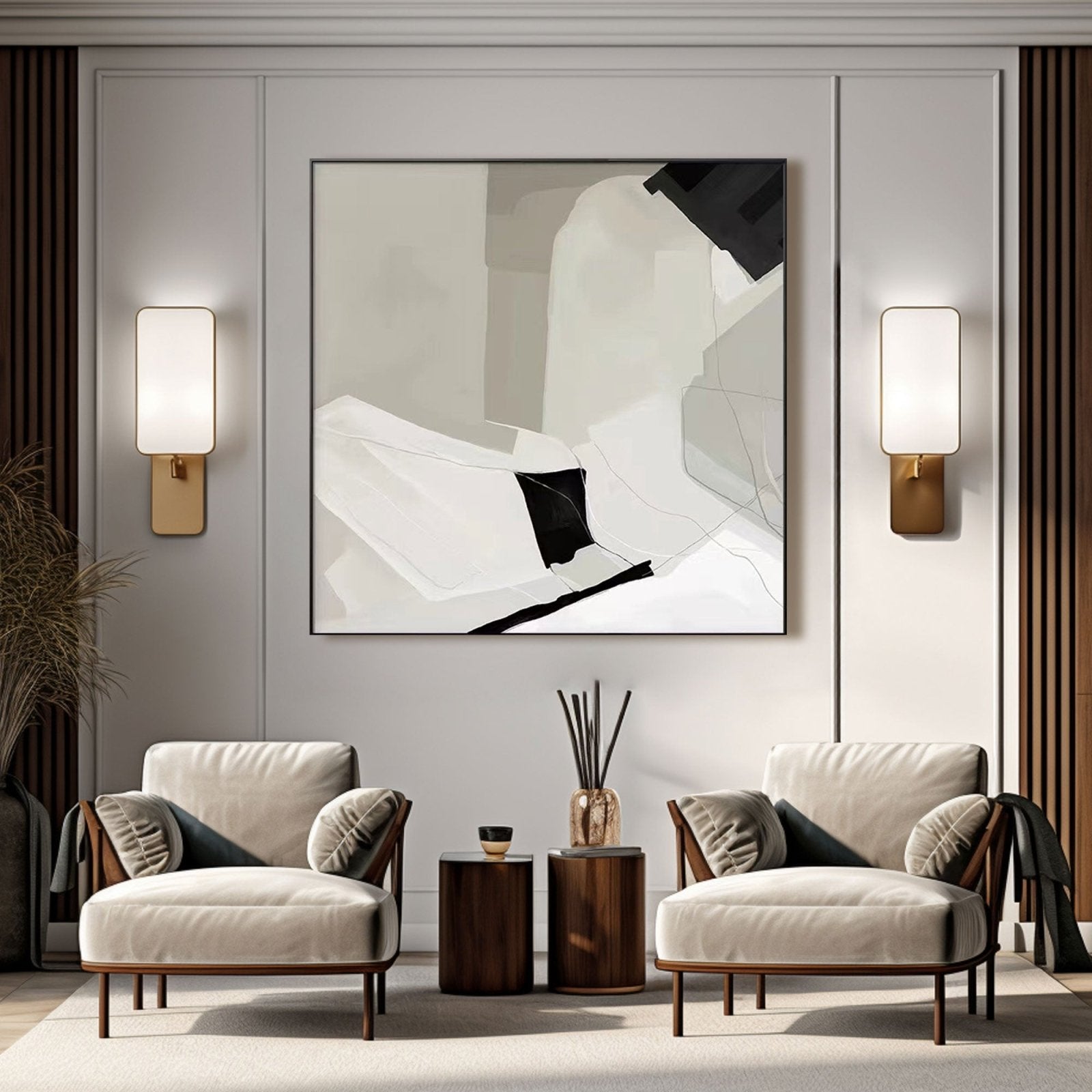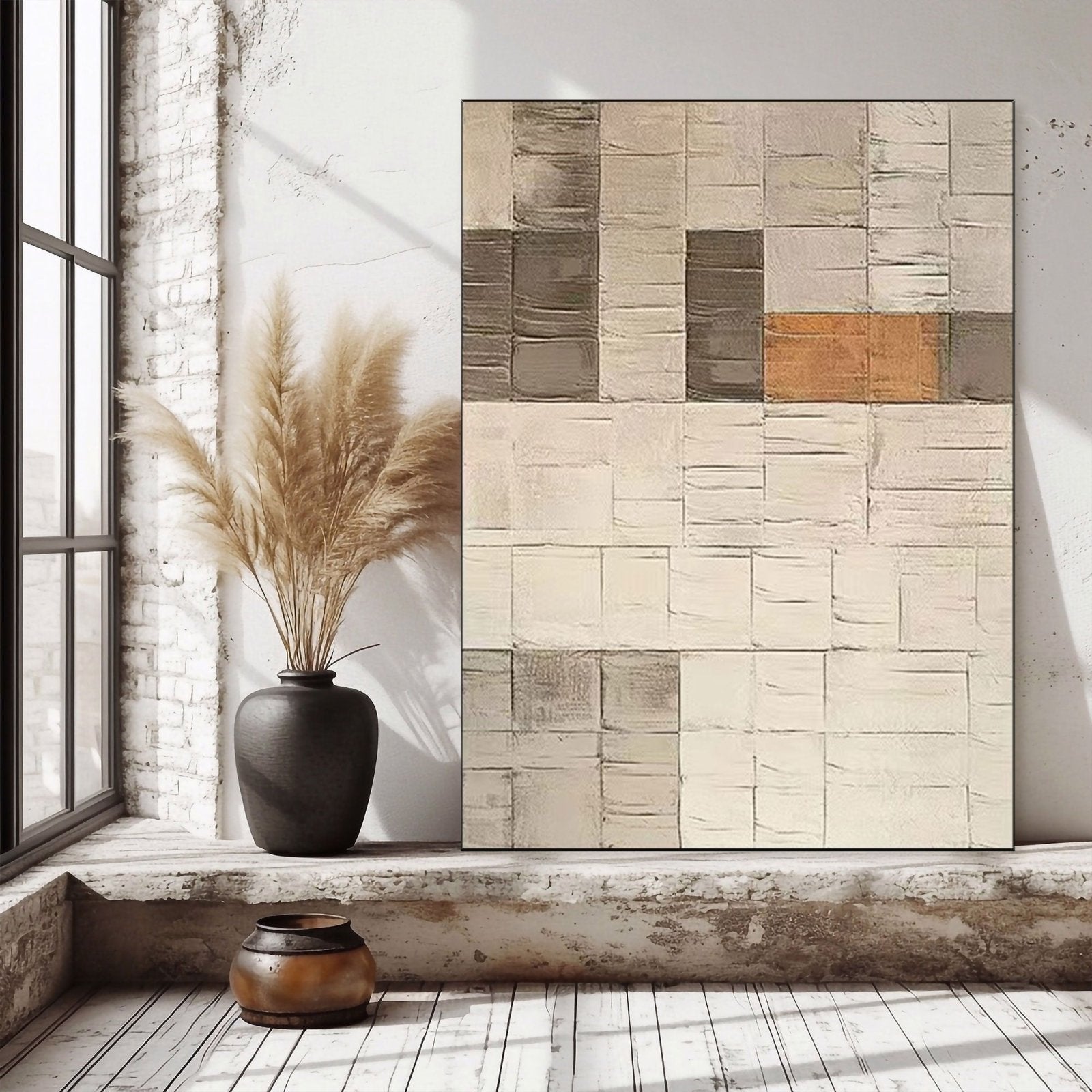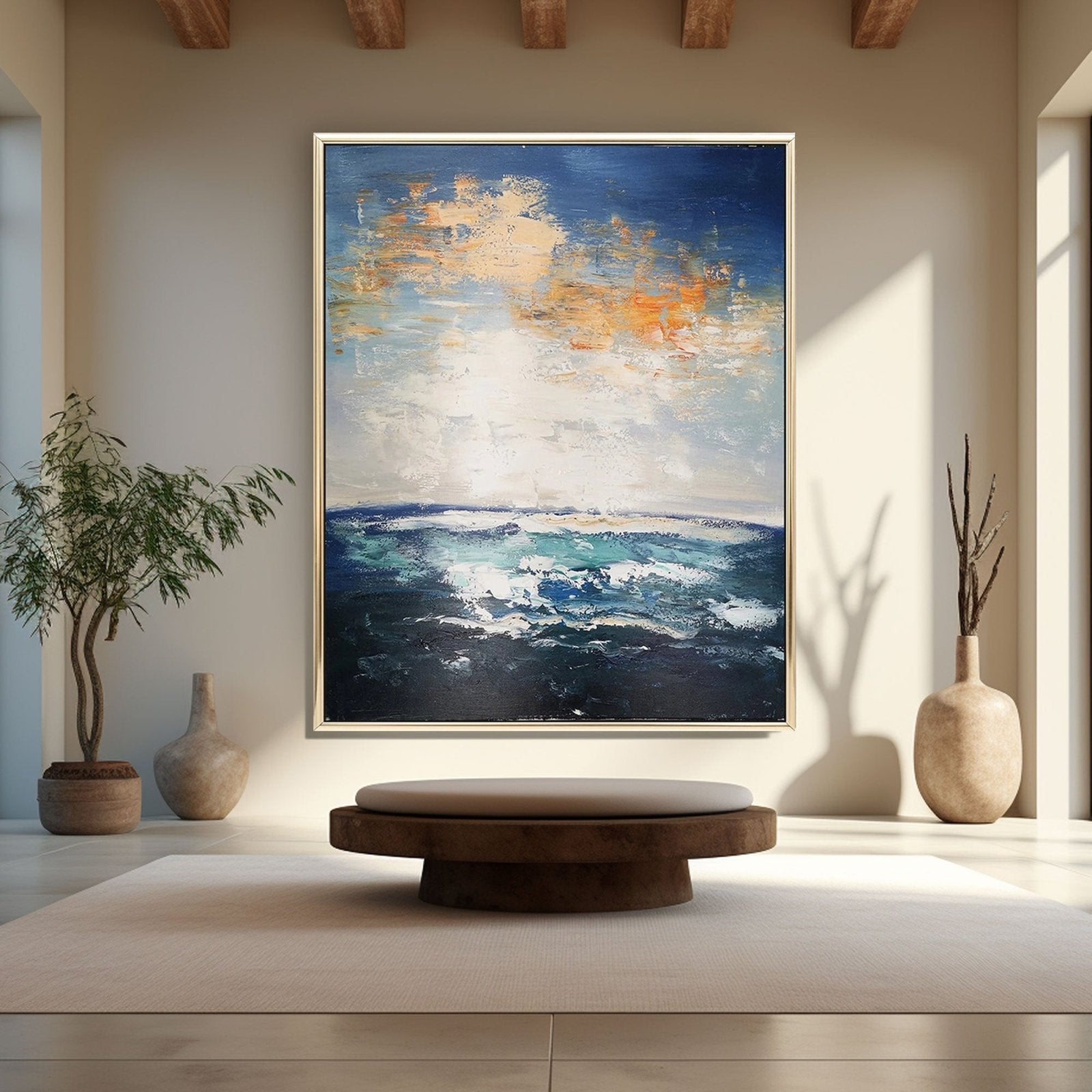
What Are the Key Elements of Abstract Black and White Art?
Have you ever found yourself stuck by an utterly captivating piece of abstract black-and-white art? That’s this undeniable allure, drawing you in with its raw essence and striking contrast.
From the interplay of shapes and textured abstract art to the dynamic lines that run across the canvas, each component tells a story waiting to be discovered.
This is like stepping into a new perspective on artistic expression where every stroke invites you on a journey of interpretation and sparks emotions you never knew you had.
So, let's embark on what elements make abstract black-and-white art so irresistibly compelling!
8 Basic Elements Of An Abstract Black And White Art.
Abstract black-and-white art typically revolves around Eight fundamental elements that together forge a complete and compelling art piece. These elements are discussed below.
1. Contrast
Contrast is the principle of making your abstract black-and-white art get its power and impact. It’s the skill of creating a visual difference between elements in the artwork–light and dark, big and small, and rough and smooth.
Now, why contrast is so important can be viewed from an example of a painting that's all one shade of gray. It might look okay, but it won't grab your attention. Now, compare that to a piece with sharp contrasts between black and white. Suddenly, you'll be hooked.
Contrast is what guides your eye around the painting, pointing out the cool parts and keeping you interested. And in abstract art, where there's no clear subject or story, contrast adds depth and keeps things intriguing.
But wait, there's more! Contrast also brings the emotions. Like, imagine a pop of white in a sea of black—it's like a burst of light in the darkness. Or how a jagged line breaks up a smooth surface, adding drama and making you stop and stare.
So yeah, contrast isn't just about making art look awesome—it's what makes each piece dynamic and totally mesmerizing.
One example of a product that effectively uses this contrast principle is the “Horizon” by NukeArt. In this masterpiece, intricate black patterns are expertly put together against a white background, creating a visually stunning artwork that draws the viewer in.
2. Line and Shape
Lines and shapes are the building blocks for those minimalistic black-and-white art. They’re tools artists make use to create captivating compositions that speak volumes without a word.
Lines aren't just there to outline the art, but they can be bold and straight, leading you on a clear path, or all wiggly and free, giving the abstract black-and-white art a funky vibe.
Think about how a simple line can convey a sense of direction, rhythm, or emotion—it's a pretty powerful element.
And then there are shapes–they’re like puzzle pieces that fit together to make the picture complete. Geometric shapes, like squares, circles, and triangles, are all about order and precision. They serve as elements for balance and harmony in the artwork, giving it a sleek, modern look.
On the other hand, organic shapes with curves and irregularities, give the impression that the painting is moving and alive.
So, In abstract art, you'll see a mash-up of these shapes and lines working together to create something totally unique. Take, for example, the Modern Geometric Wall Art “Silent Sonata” from Nuke Art Studios.

It's all about sleek lines and organic shapes, arranged in a modern and mesmerizing way. Every stroke is like a little work of art on its own, from bold squares to subtle curves, coming together to make something truly special.
3. Texture
Texture is that secret ingredient that gives abstract minimalist art its wow factor. This element gives the artwork a whole new level of richness and complexity that might otherwise feel flat and one-dimensional.
It’s a game changer for a painting, adding layers to a story and giving the piece a sense of history and complexity that draws you in and makes you want to keep looking.
So, how it’s so significant? Think about a painting that’s all smooth and shiny depicting just like a picture in the magazine. But when you add texture into the mix–whether it’s gritty, rough, soft, or velvety–it suddenly transforms the artwork alive, like there's this whole other world hidden beneath the surface.
Now, how do abstract artists create this texture? We, there are all kinds of techniques, from layering onto thick paints to carving into clay. Some go with palette knives and brushes to create a rough, uneven surface while some experiment with materials like sand or fabric to add tactile elements to the work.
And then there are techniques like stippling or sgraffito, where the artist scratches or dots the surface to create intricate patterns and textures.
You can take a look at the “Wavecrest” minimalist art piece depicting all the different layers going on. The artist has gone all out with thick brushstrokes of paint, creating these bold, chunky layers that practically force you to run your finger over and feel.
4. Composition
Composition in abstract art is where all the magic happens, bringing together different elements to create something truly captivating.
In abstract art, the composition is what gives the artwork its structure and balance, transforming a collection of lines, shapes, colors, and textures into a cohesive whole.
Here, artists play around with different components, experiment with different combinations and placements, and move them around until they find the perfect arrangement.
Sometimes they'll use symmetry to create a sense of order and stability, while other times abstract art people go for asymmetry to add a bit of spirit and energy.
This approach can make the composition feel more dynamic and alive, with a sense of movement and flow that draws the viewer’s eye around the piece.
But this isn’t as easy as it seems. It takes a keen eye and a lot of trial and error. But when it all comes together, it's a visually stunning piece with every element working together in perfect harmony.
This element is exactly well-defined in the NukeArt abstract paintings. NukeArt is known for its meticulous approach, focusing on balancing chaos and order. By being both organized and creative, abstract artists achieve compositions that feel spontaneous and deliberate at the same time, resulting in art that's not just visually striking but also deeply thought-provoking.
5. Negative Space
A negative space might sound like a complicated term in the art realm, but it’s really just about the empty and unoccupied area in an artwork. It’s usually the space around and between the main subject and it’s as important as the actual object you see.
Negative space helps to define the boundaries of the positive space and brings balance to the overall composition. Here’s how it works:
- When the positive space (the main element) in the artwork is chaotic and busy, a well-placed negative space makes the piece feel stable and grounded.
- Negative space helps highlight the main parts of the artwork. By surrounding key elements with empty space, artists can make them stand out more and grab your attention.
- Negative space can also add a deeper layer of meaning. It can symbolize emptiness, simplicity, or contrast, adding tension or harmony to the piece.
- In detailed or complex pieces, negative space prevents the artwork from feeling too cluttered. It gives your eyes a place to rest, making it easier to appreciate and understand the composition.
So, In abstract black-and-white art, negative space holds significant importance. The stark contrast between black and white emphasizes shapes and lines, making the negative space an integral part of the artwork. It’s not just background; it’s part of the story.
6. Symbolism and Emotion
Abstract black-and-white art may seem like a simple work of creativity, but it’s actually packed with the ability to convey deep emotions and symbolic meanings. Let’s understand how it adds magic to the picture.
It’s pretty clear that abstract art doesn’t rely on realistic depictions of the world. It’s all about shapes, lines, and, in the case of black and white art, the dramatic contrast between these two colors. Without color to distract you, the focus is on form and composition, making it a powerful way to express complex feelings and ideas.
- Contrast and Emotions:The sharp difference between black and white can bring out strong emotions. Black often symbolizes darkness, mystery, or sadness, while white can stand for light, purity, or hope. Together, they can create dramatic tension or a balanced harmony, depending on how they’re used.
- Minimalism and Clarity: Black and white abstract art is often minimalist, cutting away the noise and letting you focus on the raw emotions and ideas. This simplicity can convey clarity, truth, and intensity.
Common Themes and Interpretations:
- Duality and Balance:Black and white often represent opposites—good and evil, life and death, chaos and order. Artists use these contrasts to explore how these forces balance or struggle against each other in their work.
- Emotion and Mood:Bold, sharp lines and stark contrasts can evoke feelings of tension, conflict, or power. On the flip side, soft, flowing lines, and gentle transitions can evoke peace, harmony, or even a bit of sadness.
-
Symbolic Shapes: Even in abstract art, certain shapes carry meanings:
- Circles might symbolize unity, infinity, or wholeness.
- Squares and Rectangles can stand for stability, order, and reliability.
- Triangles might suggest conflict, change, or direction.
- Movement and Energy:The way lines and shapes are arranged in a piece can create a sense of movement and energy. Swirling, dynamic patterns can feel chaotic or exciting, while calm, repetitive patterns might feel more tranquil or monotonous.
7. Minimalism
The minimalist element of abstract black-and-white art means here: keeping creativity simple and focusing on the basics. In abstract art context, it refers to the use of simple forms, clean lines, and sharp contrast to create a powerful piece that says a lot with very little.
Why Go Minimalistic?
- Stripping down to essentials helps the art speak more, making it more intense and meaningful.
- The simplicity of minimalist art can be really soothing, giving you a nice break from the chaotic everyday life.
- The black and white theme can fit almost everywhere. It compliments all sorts of decor without overpowering it.
- Even with fewer elements, minimalist art can evoke strong emotions. The sharp contrasts and clean lines make a bold statement.
How To Incorporate Minimalistic Art Into The Space?
- Begin by placing the abstract art frames on neutral walls–preferably on grey, white, and beige backgrounds.
- Don't clutter your piece with too many pieces. A thoughtful chosen art piece can be more impactful than the bunch.
- Try pairing up the art with modern, clean-lined furniture. Skip the overly decorated stuff that might clash with the simplicity of the art.
- Good lighting can make a whole new difference. Go with a spotlight or natural lights that can complete the overall theme of the art.
- Place the art frame in an optimal position where everyone notices. It can be placed over a fireplace or above the sofa.
- Keep the color palette simple, but play with textures. Pairing smooth, sleek artwork with rough, natural elements can create an interesting contrast.
8. Pattern And Rhythm
In the world of abstract minimalist art, patterns, and rhythm play the role of a heartbeat. Patterns are all about repeating lines, forms, and shapes throughout the artwork, giving the piece its solid structure.
On the other hand, rhythm is how these elements flow together. Think of it as a visual beat that guides your eyes across the artwork, just like how a catchy song makes you tap your feet.
Here’s a clue of how artists use the techniques of repetition and variations to keep the art interesting.
- Repetition means using the same elements over and over again to give the artwork some stability and uniformity. Have you ever seen a series of cycles scattered over a canvas? That’s the repetition technique.
- Now, if all these circles are of the same shape, it could get pretty boring. Right? That’s where artists make use of the variation factor. Going with different-sized shapes, colors, and patterns, the artists add some spice to the artwork, making it look less monotonous.
By combining repetition and variation, artists create a rhythm that keeps your eyes moving and your mind engaged. It’s this balance that makes abstract art feel lively and dynamic.
Conclusion
So, in this journey of exploring different elements of abstract white and black art, we learned how these essential factors can create movement, energy, and depth in an art piece. We discussed how patterns and rhythm, through repetition and variation, build structure and keep the artwork dynamic. Texture adds a layer of realism, while the interplay of contrast, shapes, and lines creates a mesmerizing effect.
Black and white abstract art, in particular, demonstrates how these elements come together to form captivating compositions that engage and intrigue viewers.
Ready to bring some dynamic abstract art into your space? Check out NukeArt’s stunning collection of black and white abstract pieces. Visit NukeArt's website to browse and purchase unique artwork that will add a touch of elegance and movement to your home or office.
Discover your next favorite piece today!





